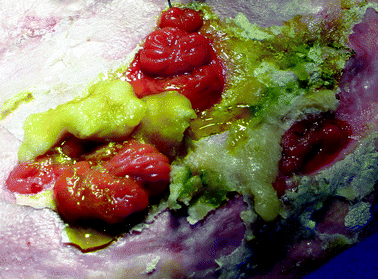Fig. 6.1
CT scan with extravasation of oral contrast out the anterior abdominal wall consistent with an enteroatmospheric fistula. © Dale Dangleben, MD
In cases where a fistula may be small and not apparent on contrast imaging, use of dye (e.g., indigo carmine, methylene blue, or charcoal) may be used. In fistulas arising from the rectum or stomach, endoscopic evaluation may provide additional information (e.g., neoplasm) and allow access to the origin of the fistula.
EAF
With the frequent tendency of being superficial, the diagnosis is oftentimes readily apparent. Anatomic information and output volumes remain important for prognosis and therapy choices.
Complications
ECF
Electrolyte disturbances, malnutrition, sepsis, skin breakdown and maceration, abscess formation, dehydration, protracted morbidity, and even multisystem organ failure Fig. 6.2.

Fig. 6.2
Multiple fistulae of the lower abdomen. © Dale Dangleben, MD
EAF
In addition to above, additional EAFs may occur during the treatment process as additional bowel segments are often exposed.
Management
ECF
Management is divided into phases of: (1) stabilization—initial 24–48 h (fluid resuscitation, drainage of intraabdominal abscesses, control of fistula drainage and skin care, reduction of fistula output, and aggressive nutritional support), (2) investigation/diagnosis—7 to 10 days (imaging to determine anatomy and fistula characteristics), (3) decision—up to 4–6 weeks (decide between operative or non-operative), (4) definitive therapy—4 to 6 months following the index operation (closure of fistula, reestablish GI continuity, and secure closure of abdomen), and (5) healing—5 to 10 days after closure onward (transition to oral intake and continue to ensure adequate nutritional support).
Determining management depends on likelihood of spontaneous closure, and decision points include fistula location and characteristics, pattern of fistula output, status of the surrounding bowel, and response to non-operative management. If fistula closure has not occurred after 4–5 week of adequate nutrition and absence of sepsis, it is 90% unlikely that a fistula will close without surgical intervention. For postoperative ECF’s, morbidity and mortality have been noted to decrease by 50% in those patients that are able to wait 4–6 months from the date of original procedure to have surgical intervention. The wait allows the obliterative peritonitis and dense fibrous adhesions to subside, resulting in reduced morbidity and mortality.
Stay updated, free articles. Join our Telegram channel

Full access? Get Clinical Tree








